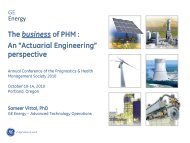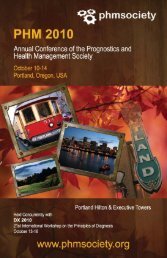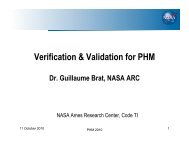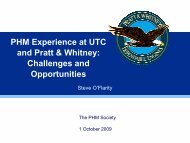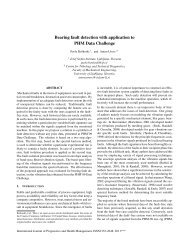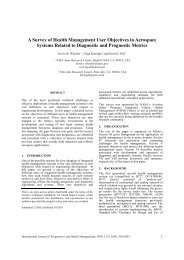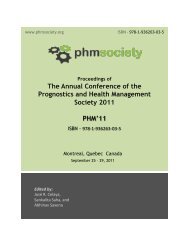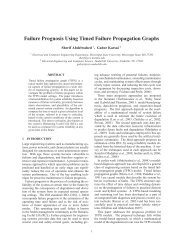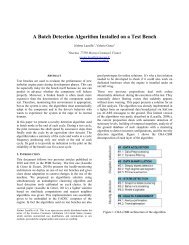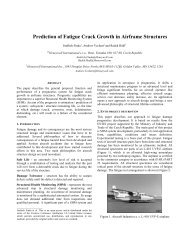A Multiple Model Prediction Algorithm for CNC ... - PHM Society
A Multiple Model Prediction Algorithm for CNC ... - PHM Society
A Multiple Model Prediction Algorithm for CNC ... - PHM Society
You also want an ePaper? Increase the reach of your titles
YUMPU automatically turns print PDFs into web optimized ePapers that Google loves.
A <strong>Multiple</strong> <strong>Model</strong> <strong>Prediction</strong> <strong>Algorithm</strong> <strong>for</strong> <strong>CNC</strong> Machine Wear <strong>PHM</strong><br />
Huimin Chen 1<br />
1 Department of Electrical Engineering, University of New Orleans, New Orleans, LA, 70148, U. S. A.<br />
hchen2@uno.edu<br />
ABSTRACT<br />
We present a multiple model approach <strong>for</strong> wear depth estimation<br />
of milling machine cutters using dynamometer, accelerometer,<br />
and acoustic emission data. The feature selection,<br />
initial wear estimation and multiple model fusion components<br />
of the proposed algorithm are explained in details and<br />
compared with several alternative methods using the training<br />
data. The per<strong>for</strong>mance evaluation procedure and the resulting<br />
scores from the submitted predictions are also discussed.<br />
1. INTRODUCTION<br />
The 2010 <strong>PHM</strong> data challenge focuses on the remaining<br />
useful life (RUL) estimation <strong>for</strong> cutters of a high<br />
speed <strong>CNC</strong> milling machine using measurements from dynamometer,<br />
accelerometer, and acoustic emission sensors<br />
(See http://www.phmsociety.org/competition/phm/10). The<br />
challenge data set contains six individual cutter records, denoted<br />
by c1, ..., c6. Records c1, c4 and c6 are training data<br />
while records c2, c3 and c5 are testing data. Each cutter was<br />
used repeatedly to cut certain work piece with the spindle<br />
speed of 10400 RPM. The wears of three flutes were measured<br />
after each cut (in 10 −3 mm). In addition, 3-component<br />
plat<strong>for</strong>m dynamometer was used to measure the cutting <strong>for</strong>ces<br />
in X, Y, Z directions. Three accelerometers were used to<br />
measure the vibrations of the cutting process in X, Y, Z directions.<br />
Acoustic emission (AE) sensor was used to measure<br />
the acoustic signature (AE-RMS) of the work piece during the<br />
cutting process. Prognostic algorithm development with similar<br />
equipment setup was reported in (Li et al., 2009). The<br />
training data contain 315 cut files <strong>for</strong> each cutter with the<br />
measured time series of <strong>for</strong>ces, vibrations and AE-RMS and<br />
the resulting wears of three flutes after each cut. The testing<br />
data only contain the <strong>for</strong>ce, vibration and AE-RMS measurements<br />
<strong>for</strong> each cut without the wear depth measurement of<br />
each flute. The goal is to estimate the maximum number of<br />
cuts one can safely make <strong>for</strong> each testing cutter at a given<br />
wear limit. Note that one has to implicitly or explicitly predict<br />
the maximum wear of the flutes after each cut without<br />
knowing the initial wear of the cutter using only the <strong>for</strong>ce,<br />
vibration and AE-RMS measurements from consecutive cuts.<br />
Upon completion of the competition, the author was invited<br />
to submit a paper that fully discloses the algorithm used in<br />
2010 <strong>PHM</strong> data challenge.<br />
The rest of the paper is organized as follows. In Section 2, we<br />
first explain the per<strong>for</strong>mance evaluation criterion of the data<br />
challenge. Then we discuss feature selection <strong>for</strong> linear regression<br />
model on the additional wear after each cut <strong>for</strong> all three<br />
cutters. Finally, we reveal the need of individual regression<br />
model <strong>for</strong> each cutter and call <strong>for</strong> a multiple model approach<br />
to predict the wear depth of the testing cutter. In Section 3,<br />
we present the detailed description of the algorithm applied to<br />
the data challenge. The concluding summary is in Section 4.<br />
2. PRELIMINARY ANALYSIS OF THE TRAINING DATA<br />
2.1 Data Challenge Submission and Score Function<br />
Each participant in 2010 <strong>PHM</strong> data challenge is required to<br />
estimate the maximum safe cuts at wear limit of 66, 67, ...,<br />
165 (×10 −3 mm) <strong>for</strong> three testing cutters. However, one does<br />
not know the actual wear after each cut and can only use the<br />
sensor measurements up to the current cut to infer the cumulative<br />
wear (although a participant can use the measurements<br />
from all 315 cuts, which is clearly unrealistic in practice).<br />
Note that the wear limit is on the maximum wear among three<br />
flutes. From the training data, we obtained the maximum safe<br />
cuts <strong>for</strong> the three training cutters in Figure 1. Clearly, c1 and<br />
c4 have early jump in the number of maximum cuts be<strong>for</strong>e<br />
wear depth reaches 100 while c6 has a small jump be<strong>for</strong>e wear<br />
depth reaches 120. These are important change points where<br />
the wear depth of the cutter is small after each cut (and in<br />
some cases unnoticeable) so that the number of safe cuts increases<br />
abruptly when the wear limit changes incrementally.<br />
Note that the initial wears of c1, c4, and c6 are 48.9, 31.4,<br />
International Journal of Prognostics and Health Management, ISSN2153-2648, 2011 011<br />
1
TECHNICAL BRIEF<br />
62.8, respectively.<br />
cut<br />
300<br />
250<br />
200<br />
150<br />
100<br />
50<br />
0<br />
60 80 100 120 140 160 180<br />
wear depth (10 −3 mm)<br />
Figure 1. Maximum safe cuts <strong>for</strong> c1, c4 and c6.<br />
Denote by δ the difference between the estimated number of<br />
cuts and the actual number of maximum cuts <strong>for</strong> a given cutter<br />
be<strong>for</strong>e it reaches the wear limit. The score function is defined<br />
as<br />
{ e<br />
S(δ) =<br />
−δ/10 − 1 δ < 0<br />
e δ/4.5 (1)<br />
− 1 δ ≥ 0<br />
The goal is to minimize the sum of scores at the given 100<br />
wear limits <strong>for</strong> all three testing cutters. Note that over estimate<br />
of the cut number has a larger penalty than under estimate.<br />
The above exponential penalty function focuses more<br />
on penalizing any single bad estimate rather than the average<br />
per<strong>for</strong>mance among all possible wear limits.<br />
2.2 Feature Extraction and Selection<br />
We first consider a regression model to estimate the additional<br />
wear after each cut assuming that the initial wear of the cutter<br />
is known. The goal is to identify useful features and to<br />
avoid overfitting to the training data. Linear regression was<br />
used with the candidate features and their p-values resulting<br />
from the regression on c1, c4, and c6 cutters in Table 2.2.<br />
A small p-value indicates the corresponding feature is likely<br />
to have non-zero regression coefficient, i.e., it should be included<br />
in wear depth estimation (Schervish, 1996). Un<strong>for</strong>tunately,<br />
most of the candidate features have relatively small p-<br />
values, making feature selection a challenging task with limited<br />
training data. Note that one can explore many candidate<br />
features including peak, mean, standard deviation, skew, kurtosis<br />
of <strong>for</strong>ce and vibration along X, Y, Z directions as well as<br />
their frequency domain indicators as listed in Table 2.2. Thus<br />
it is computationally infeasible to exhaustively enumerate all<br />
possible feature subsets with the linear regression model and<br />
choose the best one. To expedite the automatic feature selection<br />
procedure <strong>for</strong> any regression model, we do not want<br />
to test whether an individual regression coefficient should be<br />
zero or not based on p-value, instead, we control the false discovery<br />
rate (FDR) among all the selected features. It is an<br />
c1<br />
c4<br />
c6<br />
effective method <strong>for</strong> testing multiple hypotheses simultaneously<br />
(Benjamini & Hochberg, 1995).<br />
Maximum <strong>for</strong>ce 0.08<br />
Mean <strong>for</strong>ce 0.12<br />
Standard deviation of <strong>for</strong>ce 0.07<br />
Maximum vibration 0.05<br />
Mean vibration 0.06<br />
Standard deviation of vibration 0.09<br />
Maximum AE-RMS 0.06<br />
Mean AE-RMS 0.08<br />
Standard deviation of AE-RMS 0.15<br />
Peak magnitude of <strong>for</strong>ce frequency<br />
spectrum below 2000Hz 0.11<br />
Peak magnitude of vibration frequency<br />
spectrum below 2000Hz 0.07<br />
Peak magnitude of AE-RMS frequency<br />
spectrum above 2000Hz 0.14<br />
Table 1. Candidate features and the corresponding p-values<br />
in linear regression<br />
Formally, we consider d candidate features to be possibly included<br />
in the linear regressor. A hypothesis H k describes the<br />
index set I k ⊆ {1, · · · , d} of the non-zero regression coefficients<br />
of w, i.e., the selected feature subset.<br />
H k : w i ≠ 0 if i ∈ I k , otherwise w i = 0, i = 1, · · · , d.<br />
We apply the FDR control technique to estimate I k . Note<br />
that the procedure does not require any independence assumption<br />
of the test statistics which is important in our case since<br />
some candidate features can have strong correlations in the<br />
regression model. The feature selection procedure is a stepdown<br />
test (by successively selecting features) which is more<br />
efficient than a step-up test (by successively eliminating nondiagnostic<br />
features) when the number of selected features is<br />
relatively small compared with d. The procedure starts with<br />
the test statistic T 1 , · · · , T d based on the element-wise estimate<br />
ŵ 1 , · · · , ŵ d . Each test statistic T i is associated with a p-<br />
value, π i , indicating its statistical significance when w i = 0.<br />
For any user specified FDR level q ∈ (0, 1), the feature subset<br />
is selected by per<strong>for</strong>ming the following steps which controls<br />
the FDR to be below q (Chen, Bart, & Huang, 2008).<br />
• Order the p-values such that π (1) ≤ · · · ≤ π (d) .<br />
(<br />
)<br />
d<br />
• Compute the index u i = min 1,<br />
(d−i+1)<br />
q 2 , i =<br />
1, ..., d.<br />
• Reject all hypotheses w (j) = 0 <strong>for</strong> 1 ≤ j ≤ k − 1 where<br />
k is the smallest index <strong>for</strong> which π (k) > u k . If no such k<br />
exists, then w = 0.<br />
Once the subset Îk is determined, the regression coefficients<br />
should be recomputed using only the selected input features.<br />
Clearly, the FDR controlled feature selection procedure is<br />
2
TECHNICAL BRIEF<br />
much more efficient than finding the optimal feature subset<br />
via enumeration. It has been shown that the above procedure<br />
does control the FDR at the significance level q (Chen et al.,<br />
2008).<br />
wear depth (10 −3 mm)<br />
250<br />
200<br />
150<br />
100<br />
50<br />
0<br />
0 50 100 150 200 250 300 350<br />
cycle<br />
Figure 2. Flute wear after each cut and the maximum wear<br />
<strong>for</strong> cutter c1, c4, c6.<br />
We set q=0.1 and applied linear regression to 68 candidate<br />
features. Only 5 features were selected based on the training<br />
data. With the selected features, we obtained the regressed additional<br />
wear <strong>for</strong> c1, c4 and c6 and the score being 3·10 6 . We<br />
also tried to build the linear regression model <strong>for</strong> the wear of<br />
each flute instead of using the maximum wear after each cut.<br />
Figure 2 shows the individual flute wear and the maximum<br />
wear after each cut <strong>for</strong> the three training cutters. With the<br />
same FDR control level, the resulting score becomes 4 · 10 6<br />
owing to the regression model fitting to the individual wear<br />
of each flute instead of the maximum wear. However, when<br />
we applied linear regression to c1 and c4 and the resulting<br />
model to estimate the wear of c6, the score becomes 2 · 10 8 .<br />
Similar effects were observed when using c1 and c6 to build<br />
the model and estimate the wear of c4 as well as using c4 and<br />
c6 to estimate the wear of c1. Note that the results are based<br />
on the true initial wear of the cutter. It is clear that the linear<br />
regression method on the selected features tends to overfit<br />
even with fairly restrictive FDR control. The resulting score<br />
on the training set is unsatisfactory. 1 From the preliminary<br />
data analysis, we concluded that<br />
• A single linear regression model yields large estimation<br />
error of the wear depth even with controlled FDR in feature<br />
selection.<br />
• Regression on the additional wear after each cut <strong>for</strong> individual<br />
flute does not gain any benefit compared with<br />
regression on the maximum wear.<br />
1 At the time that I registered <strong>for</strong> 2010 <strong>PHM</strong> data challenge, the top score on<br />
the leader board was already 4 · 10 5 on testing data without knowing the<br />
initial wear on each cutter.<br />
c6<br />
c4<br />
c1<br />
• No small subset of the candidate features can correlate<br />
well with the maximum wear after each cut <strong>for</strong> all training<br />
cutters.<br />
3. MULTIPLE MODEL PREDICTION ALGORITHM<br />
3.1 Building Regression <strong>Model</strong> <strong>for</strong> Each Cutter<br />
We assume that each cutter has its own model to estimate the<br />
additional wear after each cut based on the selected features.<br />
In general, we consider a class of models M 1 , ..., M K where<br />
model M i assumes that the observation z is governed by a<br />
likelihood functional f i (z|θ i ) depending on the unknown parameter<br />
θ i (i = 1, ..., K). The dimension of θ i is denoted<br />
by p i . Denote by z n a vector of n independent observations.<br />
Given z n , one wants to find the best model M i among the K<br />
candidates. Existing model selection criteria can be written in<br />
a general <strong>for</strong>m (Chen & Huang, 2005)<br />
l j = − log f j (z n |ˆθ j ) + d j (z n ), j = 1, ..., K (2)<br />
being minimized among the K candidates. The first term of<br />
l j uses the best estimate of θ j to fit the negative log-likelihood<br />
function. The second term d j (z n ) is a penalty function that<br />
varies <strong>for</strong> different model selection criteria.<br />
From our past experience, we applied the minimum description<br />
(<br />
length (MDL) criterion which yields d j (z n )<br />
∫ )<br />
=log fj (z n |ˆθ j )dz n . It is interpreted as part of the normalized<br />
maximum likelihood (NML) (Rissanen, 1996). Under<br />
certain regularity conditions, one can use the asymptotic<br />
expansion of d j (z n ) given by<br />
d j (z n ) = p (<br />
j n<br />
) ∫<br />
2 log + log |I(θ j )| 1/2 dθ j (3)<br />
2π<br />
where I(θ j ) is the Fisher in<strong>for</strong>mation matrix given by<br />
[<br />
1<br />
I(θ j ) = lim<br />
n→∞ n E − ∂2 log f j (z n ]<br />
|θ j )<br />
∂θ j (∂θ j ) ′<br />
and the integral in (3) is over an appropriate subset of the<br />
parameter space. The MDL criterion intends to minimize the<br />
overall code length of a model and the observation described<br />
by the model.<br />
As a special case of the above MDL principle, we assume that<br />
the additional wear of each cutter is a polynomial function<br />
of the selected features of unknown order. Thus <strong>for</strong> model<br />
M i , the observation equation is y = H i θ i + w i where H i<br />
is a known n × p i matrix; θ i is an unknown p i × 1 vector;<br />
and w ∼ N (0, σ 2 I) is the Gaussian noise vector with unknown<br />
variance σ 2 . The minimum variance unbiased (MVU)<br />
estimate of θ i is ˆθ i = (H T i H i) −1 H T i y. The residual sum of<br />
squares (RSS) of ˆθ i is R i = ||y − H i ˆθi || 2 . The MVU estimate<br />
of σ 2 is ˆσ i 2 = R i/(n − p i ), which is different from the ML estimate<br />
given by R i /n. The MDL based on the NML density<br />
minimizes the cost (Rissanen, 1996)<br />
MDL(p i ) = n 2 log (ˆσ i<br />
2 ) p i + 1 + log F i + L i (5)<br />
2<br />
(4)<br />
3
TECHNICAL BRIEF<br />
( )<br />
where F i = (y T y − R i )/(p iˆσ i 2) and L i = 1 2 log n−pi<br />
.<br />
p 3 i<br />
We control the FDR level q=0.1 as be<strong>for</strong>e. For cutter c1, 7<br />
features were selected resulting in a score of 3 · 10 3 from the<br />
penalized regression model. Interestingly, 6 features were selected<br />
(4 of which are identical to those used <strong>for</strong> c1) <strong>for</strong> cutter<br />
c4 leading to a score of 2 · 10 3 . 9 features were selected <strong>for</strong><br />
cutter c6 (including all 6 featured used <strong>for</strong> c4) leading to a<br />
score of 2 · 10 3 . We can see that three training cutters with<br />
different regression models have much better accuracy in estimating<br />
the wear depth than using a single regression model.<br />
However, we can no longer per<strong>for</strong>m cross validation on the<br />
resulting models with the training data.<br />
3.2 <strong>Multiple</strong> <strong>Model</strong> Fusion<br />
From the Bayesian point of view, selecting a single model to<br />
make prediction or interpolation ignores the uncertainty left<br />
by finite data as to which model is the correct one. Thus a<br />
Bayesian <strong>for</strong>malism uses all possible models in the model<br />
space under consideration when making predictions, with<br />
each model weighted by its “posterior” probability being the<br />
correct one. The approach is called Bayesian model averaging<br />
and widely used in combining different learning algorithms<br />
(MacKay, 1992). The major difficulty in applying the<br />
Bayesian approach lies in the specification of priors when the<br />
candidate models are nested or partially overlapped. To be<br />
more specific, assuming that we have the observation vector<br />
z n , the likelihood of a new observation y can be approximated<br />
by<br />
K∑<br />
f(y|z n ) ≈ P (M i |z n )f i (y|ˆθ i ) (6)<br />
i=1<br />
using multiple models while the single model likelihood is<br />
f i (y|ˆθ i ) if model M i is selected. Without assigning prior to<br />
θ i , one can not apply Bayes <strong>for</strong>mula to estimate the model<br />
probability.<br />
If one does not stick to the <strong>for</strong>mal Bayesian solution, then the<br />
penalty l i in the model selection criterion can be used to estimate<br />
the model probability. We apply the following estimator<br />
⎛ ⎞<br />
K∑<br />
P (M i |z n ) = e −l i<br />
/ ⎝ ⎠ (7)<br />
j=1<br />
e −l j<br />
and use MDL <strong>for</strong> l i . In our opinion, the model probability<br />
can not be interpreted as the posterior since the prior of θ i is<br />
unspecified. It represents the self-assessment of how likely<br />
M i is selected using the criterion l i . Denote by ŷ i the estimate<br />
(prediction or interpolation) of y using M i . The single<br />
model estimate uses ŷ i if M i is selected as the best model.<br />
The multiple model estimate uses<br />
K∑<br />
ŷ = P (M i |z n )ŷ i (8)<br />
i=1<br />
and a subset of the K models can be identified based on<br />
a predetermined minimum model probability. Note that the<br />
outcome provided via multiple model fusion is valid <strong>for</strong> any<br />
model set, not limited to linear models. The essence of (7) is<br />
to approximate the Bayesian evidence of each model without<br />
any dependence on the unknown parameter θ i so that all data<br />
can be used <strong>for</strong> the inference purpose, i.e., parameter estimation<br />
(Chen & Huang, 2005). If we know the initial wear of the<br />
testing cutter, then we can apply the above prediction method<br />
with three regression models obtained from the training data.<br />
3.3 Initial Wear Estimate and RUL <strong>Prediction</strong><br />
Typically, the initial wear of the testing cutter should be<br />
known to the algorithm developer. Then <strong>for</strong> each cut, one collects<br />
the sensor measurements and sequentially predicts the<br />
additional wear after the cut. However, this in<strong>for</strong>mation was<br />
unavailable during the competition. To estimate the initial<br />
wear, we made a hypothesis that the standard deviation of the<br />
high frequency peak from AE-RMS measurements correlates<br />
with the cutter’s initial wear. This also has a statistical support<br />
with relatively small p-value from the linear regression<br />
model. We extrapolate from the three training cutters and obtained<br />
the estimated initial wears <strong>for</strong> c2, c3, c5 being 60, 55,<br />
45, respectively. Note that we have used the AE-RMS measurements<br />
from the testing cutter of the first 15 cuts, which<br />
seems reasonable in practice.<br />
With the estimated initial wear and the three regression models<br />
learned from the training data, we apply the multiple<br />
model algorithm via sequentially estimating the model probabilities<br />
after each cut by processing new sensor measurements<br />
and combining the individual predictions using (8).<br />
The resulting prediction of the maximum safe cuts is shown<br />
in Figure 3 where one can see that the prediction looks like a<br />
weighted average of the wears made by c1, c4, and c6. The<br />
first submission (with alias UNO-<strong>PHM</strong>) to 2010 <strong>PHM</strong> data<br />
challenge had a score of 9 · 10 5 , which was among those top<br />
per<strong>for</strong>mance teams on the leader board.<br />
cycle number<br />
300<br />
250<br />
200<br />
150<br />
100<br />
50<br />
0<br />
60 80 100 120 140 160 180<br />
wear depth (10 −3 mm)<br />
Figure 3. First submission to <strong>PHM</strong> data challenge <strong>for</strong> cutter<br />
c2, c3, c5 (maximum safe cuts of c1, c4, c6 included <strong>for</strong><br />
comparison).<br />
c1<br />
c2<br />
c3<br />
c4<br />
c5<br />
c6<br />
4
TECHNICAL BRIEF<br />
4. CONCLUSION<br />
We provided detailed description of the multiple model prediction<br />
algorithm with automatic feature selection and initial<br />
wear estimation submitted to 2010 <strong>PHM</strong> data challenge. The<br />
final submission ranked #2 among professional and student<br />
participants and the method is applicable to other data driven<br />
<strong>PHM</strong> problems.<br />
MacKay, D. (1992). Bayesian Interpolation. Neural Computation,<br />
4, 415-447.<br />
Rissanen, J. (1996). Fisher In<strong>for</strong>mation and Stochastic Complexity.<br />
IEEE Trans. on In<strong>for</strong>mation Theory, 42, 40-47.<br />
Schervish, M. (1996). P Values: What They Are and What<br />
They Are Not. The American Statistician, 50(3), 203-<br />
206.<br />
ACKNOWLEDGMENTS<br />
The author wants to express his gratitude to Dr. Neil Eklund<br />
<strong>for</strong> organizing the 2010 <strong>PHM</strong> data challenge and inviting him<br />
to the special session, to Dr. Kai Goebel <strong>for</strong> hosting his visit<br />
to NASA Ames Research Center, arranging stimulating discussions<br />
with his team members on various prognostic problems,<br />
and to the ij<strong>PHM</strong> editor, Dr. Abhinav Saxena, as well<br />
as anonymous reviewers <strong>for</strong> providing constructive comments<br />
on an earlier version of this paper.<br />
He is also grateful to the research sponsorship in part by ARO<br />
through grant W911NF-08-1-0409, ONR-DEPSCoR through<br />
grant N00014-09-1-1169, and Louisiana Board of Regents<br />
through NASA EPSCoR DART-2 and NSF(2010)-LINK-50.<br />
NOMENCLATURE<br />
δ<br />
d<br />
w i<br />
π i<br />
y<br />
ŷ<br />
M i<br />
θ i<br />
f i<br />
l i<br />
z n<br />
estimation error of maximum safe cuts<br />
number of candidate features<br />
regression coefficient of feature i<br />
p-value of feature i<br />
observation or quantity to be estimated<br />
estimate of y<br />
statistical model i<br />
unknown parameter associated with model i<br />
likelihood function of model i<br />
penalized log-likelihood function of model i<br />
n independent observations<br />
Huimin Chen received the B.E. and M.E. degrees from<br />
Department of Automation, Tsinghua University, Beijing,<br />
China, in 1996 and 1998, respectively, and the Ph.D.<br />
degree from the Department of Electrical and Computer<br />
Engineering, University of Connecticut, Storrs, in 2002, all<br />
in electrical engineering. He was a post doctorate research<br />
associate at Physics and Astronomy Department, University<br />
of Cali<strong>for</strong>nia, Los Angeles, and a visiting researcher with<br />
the Department of Electrical and Computer Engineering,<br />
Carnegie Mellon University from July 2002 where his research<br />
focus was on weak signal detection <strong>for</strong> single electron<br />
spin microscopy. He joined the Department of Electrical<br />
Engineering, University of New Orleans in Jan. 2003 and is<br />
currently an Associate Professor. His research interests are<br />
in general areas of signal processing, estimation theory, and<br />
in<strong>for</strong>mation theory with applications to target detection and<br />
target tracking.<br />
REFERENCES<br />
Benjamini, Y., & Hochberg, Y. (1995). Controlling the False<br />
Discovery Rate - A Practical and Powerful Approach<br />
to <strong>Multiple</strong> Testing. Journal of the Royal Statistical<br />
<strong>Society</strong>, B57(1), 289-300.<br />
Chen, H., Bart, H., & Huang, S. (2008). Integrated Feature<br />
Selection and Clustering <strong>for</strong> Taxonomic Problems<br />
within Fish Species Complexes. Journal of Multimedia,<br />
3(3), 10-17.<br />
Chen, H., & Huang, S. (2005). A Comparative Study on<br />
<strong>Model</strong> Selection and <strong>Multiple</strong> <strong>Model</strong> Fusion. In International<br />
Conference on In<strong>for</strong>mation Fusion.<br />
Li, X., Lim, B., Zhou, J., Huang, S., Phua, S., Shaw, K., et<br />
al. (2009). Fuzzy Neural Network <strong>Model</strong>ling <strong>for</strong> Tool<br />
Wear Estimation in Dry Milling Operation. In Annual<br />
Conference of the Prognostics and Health Management<br />
<strong>Society</strong>.<br />
5




